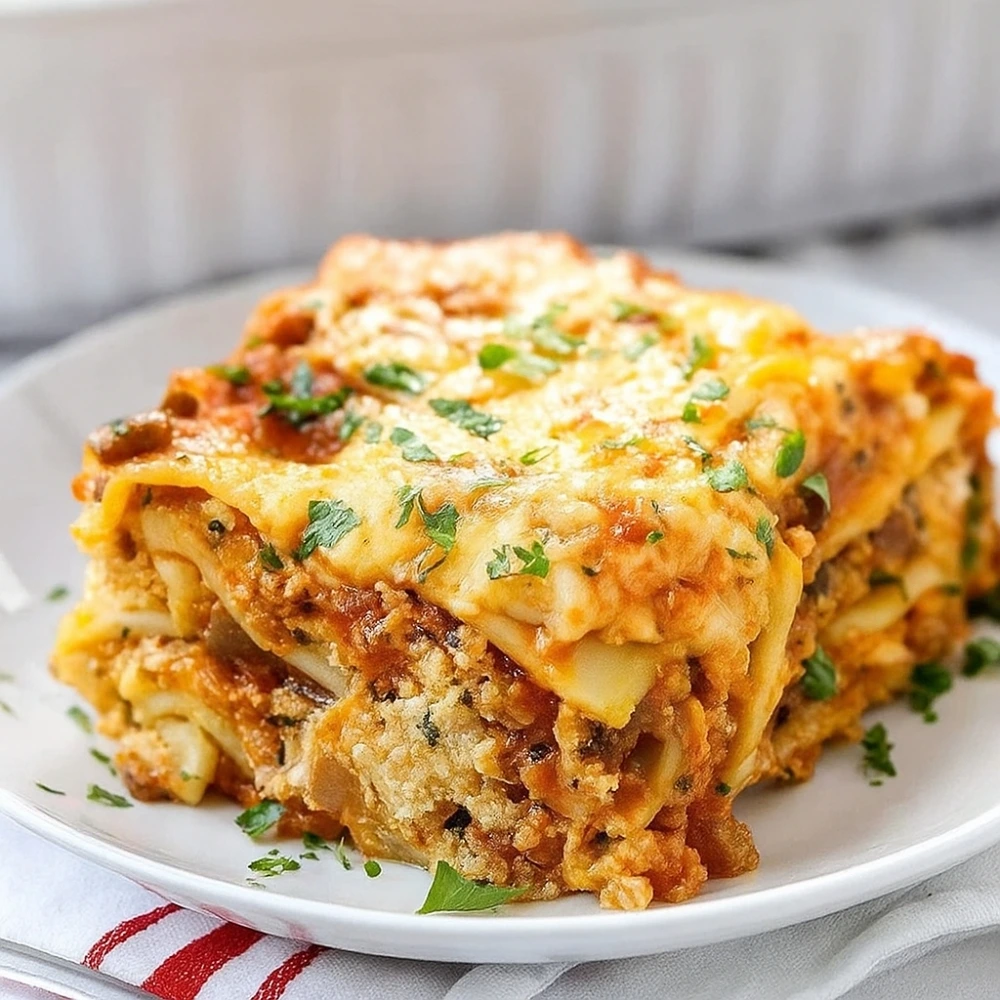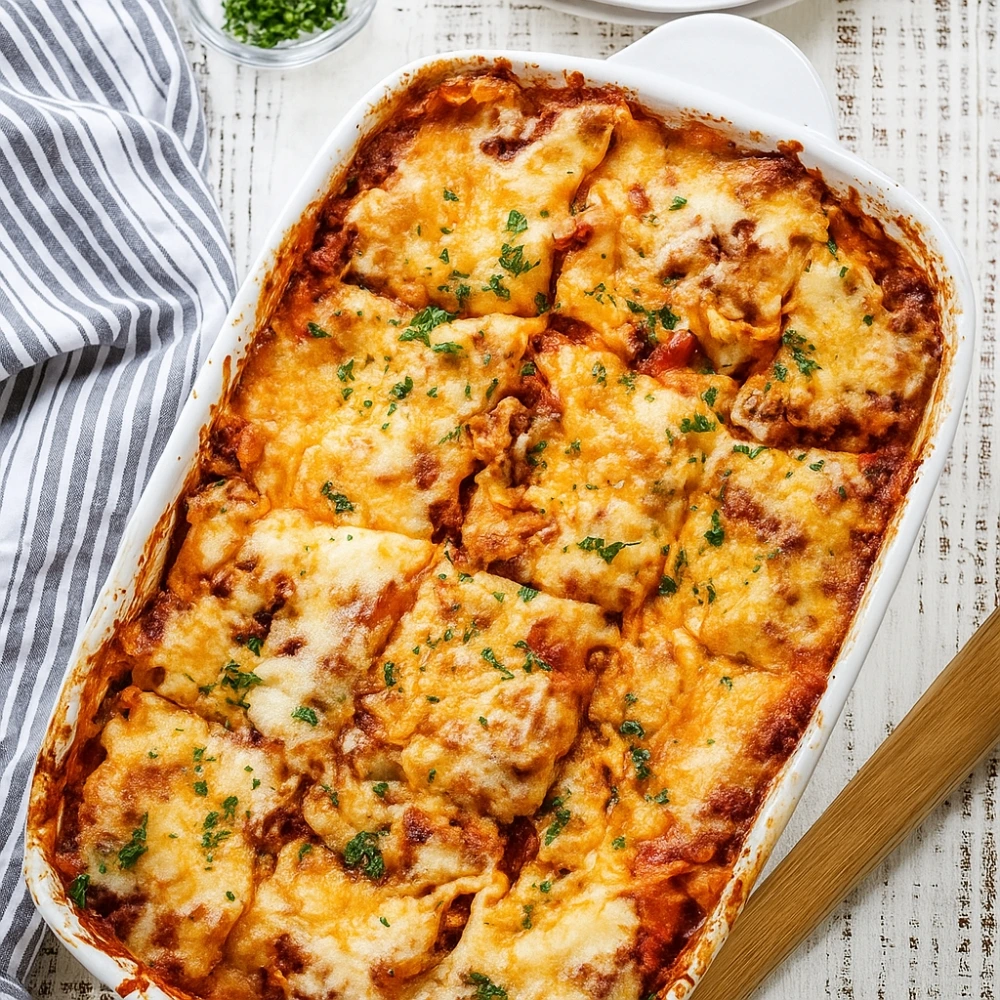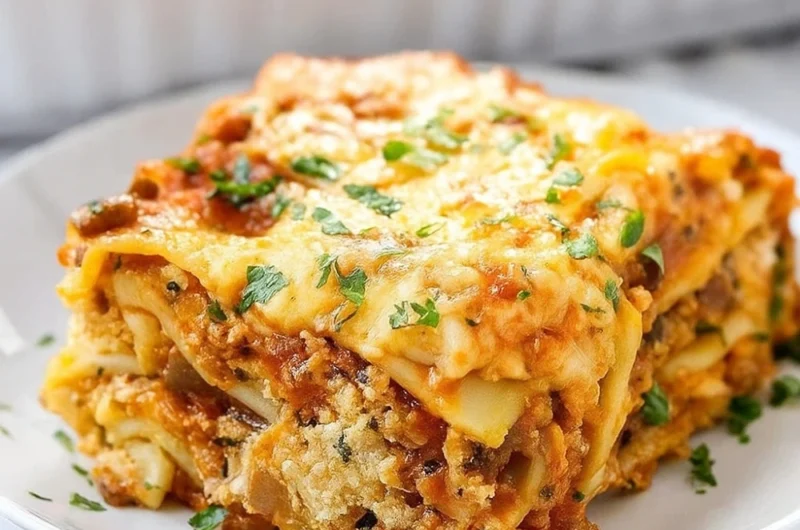The Best Fluffy Pancakes recipe you will fall in love with. Full of tips and tricks to help you make the best pancakes.
Lasagna : Master Classic Flavor

Ever dreamed of perfect homemade lasagna, only to end up with a watery mess or dry, flavorless layers? You’re not alone. The truth is, creating foolproof lasagna requires understanding not just what to do, but why certain techniques work. This comprehensive guide will transform you from a frustrated cook into a lasagna master, equipping you with the knowledge to achieve consistently perfect, rich, and customizable results every single time.
This isn’t just another homemade lasagna recipe—it’s your definitive resource for mastering the art and science of Italy’s most beloved comfort food.
The Foundation: Classic Lasagna Recipe (Our Base)
Before we dive into troubleshooting and customization, let’s establish our foundation with a traditional best lasagna recipe featuring rich Bolognese and silky béchamel sauce.
Core Ingredients
For the Bolognese Sauce:
- 2 tbsp olive oil
- 1 large onion, finely chopped
- 2 carrots, finely diced
- 2 celery stalks, finely diced
- 500g ground beef (80/20 blend for optimal flavor)
- 200g Italian sausage, casings removed
- 3 cloves garlic, minced
- 150ml red wine
- 800g crushed tomatoes
- 3 tbsp tomato paste
- 2 tsp dried oregano
- 1 tsp dried basil
- Salt and black pepper to taste
For the Béchamel Sauce:
- 4 tbsp butter
- 4 tbsp all-purpose flour
- 600ml whole milk (warm)
- Pinch of nutmeg
- Salt and white pepper
Assembly Components:
- 12-15 lasagna noodles (oven-ready or pre-cooked)
- 400g fresh mozzarella, shredded
- 150g Parmesan cheese, grated
- Fresh basil for garnish
Step-by-Step Instructions
Preparing the Bolognese (90 minutes):
- Build the flavor base: Heat olive oil over medium heat. Sauté onion, carrots, and celery until softened (8-10 minutes). This vegetable mixture, called soffritto, creates depth.
- Brown the meats: Increase heat to medium-high. Add ground beef and sausage, breaking into small pieces. Cook until deeply browned (10-12 minutes). Don’t rush this—caramelization equals flavor.
- Deglaze and simmer: Add garlic and cook 1 minute. Pour in red wine, scraping up browned bits. Let reduce by half (3-4 minutes).
- Build the sauce: Stir in crushed tomatoes, tomato paste, oregano, and basil. Reduce heat to low and simmer uncovered for 60 minutes, stirring occasionally. The sauce should thicken significantly—this is crucial for preventing watery lasagna.
Creating Silky Béchamel (15 minutes):
- Make the roux: Melt butter over medium heat. Whisk in flour and cook for 2 minutes until golden (not brown). This eliminates the raw flour taste.
- Add milk gradually: Pour warm milk in three additions, whisking constantly to prevent lumps. After each addition, whisk until smooth before adding more.
- Season and thicken: Add nutmeg, salt, and white pepper. Simmer gently for 5 minutes until coating the back of a spoon. The consistency should resemble heavy cream.
Assembly & Baking:
- Prep your dish: Preheat oven to 375°F (190°C). Spread 1/2 cup Bolognese on the bottom of a 9×13-inch baking dish.
- Layer strategically:
- First layer: 3-4 noodles
- 1/3 Bolognese sauce
- 1/4 béchamel sauce
- 1/3 mozzarella
- Sprinkle of Parmesan
- Repeat twice more
- Final layer: noodles, remaining béchamel, remaining cheeses
- Bake covered: Cover tightly with foil and bake for 40 minutes. This traps steam and cooks the noodles thoroughly.
- Brown the top: Remove foil and bake additional 15 minutes until golden and bubbling.
- Rest properly: This is non-negotiable—let lasagna rest for 20-30 minutes before cutting. This allows the layers to set and prevents a soupy mess.
Total Time: Prep: 45 minutes | Cook: 1 hour | Rest: 30 minutes | Serves: 8-10
Mastering the Elements: Deep Dives & Pro Tips
Crafting the Perfect Bolognese
The secret to exceptional authentic Bolognese sauce for lasagna lies in patience and technique:
Key Principles:
- Low and slow wins: Simmering for at least one hour allows flavors to meld and excess moisture to evaporate
- Meat-to-tomato ratio: Use roughly 3 parts meat to 4 parts tomato for richness without overwhelming acidity
- Fat content matters: Choose 80/20 ground beef—the fat carries flavor and prevents dryness
- Wine’s purpose: Red wine adds complexity and helps break down proteins for tender meat
Pro Tip: Make your Bolognese the day before. Overnight refrigeration allows flavors to develop and makes excess fat easy to skim off the top.
The Art of Silky Béchamel
Many homemade lasagna recipes overlook the importance of best béchamel for lasagna, but this creamy layer is what separates good from extraordinary.
Troubleshooting Béchamel:
| Problem | Cause | Solution |
|---|---|---|
| Lumpy sauce | Cold milk added too quickly | Always warm milk first; whisk constantly |
| Too thin | Insufficient cooking time | Simmer 5-7 minutes until thickened |
| Too thick | Too much flour or overcooked | Add warm milk 1 tbsp at a time |
| Bland flavor | Under-seasoned | Add nutmeg, salt, and consider bay leaf while simmering |
Ricotta Alternative: If béchamel feels intimidating, mix 500g ricotta with 1 egg, 1/4 cup Parmesan, and fresh herbs. It’s simpler but less traditional.
Noodle Know-How
Your noodle choice dramatically impacts texture and moisture content:
Oven-Ready Noodles:
- ✅ Convenient, no pre-cooking required
- ✅ Absorb excess moisture from sauce
- ⚠️ Require saucier layers (they’ll absorb 1/4 cup liquid per layer)
- ⚠️ Can be chewy if sauce is too thick
Fresh Pasta:
- ✅ Superior texture and authentic taste
- ✅ Cooks quickly, tender layers
- ⚠️ More expensive and time-consuming
- ⚠️ Can become mushy if over-sauced
Dried Pasta (Pre-cooked):
- ✅ Good texture control, prevents watery results
- ✅ Budget-friendly
- ⚠️ Extra prep step required
- ⚠️ Must cook al dente (it continues cooking in oven)
Layering Strategy: The Secret Sauce
Proper layering ensures structural integrity and even cooking:
The Golden Rule: Sauce → Noodles → Bolognese → Béchamel → Cheese → Repeat
Why This Order Matters:
- Sauce on bottom prevents sticking and provides moisture for bottom noodles
- Bolognese before béchamel ensures meat flavor in every bite
- Cheese between layers creates cohesion; cheese on top creates that coveted golden crust
- End with béchamel and cheese on top layer for moisture protection
Avoid These Mistakes:
- ❌ Starting with noodles (they’ll stick and burn)
- ❌ Uneven sauce distribution (leads to dry spots)
- ❌ Too many layers (4 is ideal; more can be unstable)
The Troubleshooting Manual: Common Lasagna Problems SOLVED!
Why is My Lasagna Watery? (and How to Fix It!)
This is the #1 complaint about homemade lasagna, but it’s completely preventable. Understanding how to prevent watery lasagna requires identifying the culprit:
Common Causes & Solutions:
1. Sauce Too Thin
- Problem: Bolognese sauce hasn’t reduced enough
- Solution: Simmer uncovered for full 60+ minutes. Sauce should coat a spoon thickly and leave no puddle when scooped
- Test it: Place a spoonful on a plate—if liquid pools around the edges, keep cooking
2. High-Moisture Vegetables
- Problem: Mushrooms, zucchini, or spinach release water during baking
- Solution: Always pre-cook and drain vegetables. For mushrooms, sauté until liquid evaporates completely. For spinach, squeeze out excess water using cheesecloth
- Pro tip: Salt vegetables, let sit 15 minutes, then blot—this draws out moisture before cooking
3. Wet Ricotta
- Problem: Ricotta cheese contains significant moisture
- Solution: Drain ricotta in a fine-mesh strainer for 30 minutes before mixing
- Alternative: Mix 1 tbsp cornstarch into ricotta to absorb excess liquid
4. Insufficient Resting Time
- Problem: Cutting lasagna immediately after baking
- Solution: Wait 20-30 minutes minimum. During resting, starches in noodles absorb liquid and layers set properly
- The science: Hot liquids are less viscous; as lasagna cools, fats and proteins solidify, creating structure
5. Wrong Noodle Type
- Problem: Fresh pasta with already-wet sauce
- Solution: Use oven-ready noodles with wetter sauces; they absorb excess moisture. Use pre-cooked dried pasta for better control
Quick Reference: Watery Lasagna Prevention Checklist
- ☑ Thick, reduced Bolognese sauce
- ☑ Pre-cooked and drained vegetables
- ☑ Drained ricotta (if using)
- ☑ Proper noodle choice for sauce consistency
- ☑ Covered baking (prevents excess moisture from escaping too quickly)
- ☑ 20-30 minute rest time before serving
Rescuing Dry or Bland Lasagna
On the opposite end of the spectrum, dry lasagna is equally frustrating but fixable.
Why Lasagna Gets Dry:
Insufficient Sauce:
- Each noodle layer needs about 3/4 cup total sauce coverage
- Don’t skimp—sauce provides moisture and flavor
- If using oven-ready noodles, increase sauce by 25%
Over-Baking:
- Baking too long or at too high temperature evaporates moisture
- Always cover with foil for first 40 minutes
- Check at 50 minutes—if edges are browning too fast, lower temperature to 350°F
Lean Meat:
- Using 90/10 or 95/5 ground beef removes flavorful fat
- Fat carries flavor and creates moisture—stick with 80/20 blend
- Consider mixing in Italian sausage for added richness
Under-Seasoning:
- Taste your sauce before assembling and adjust seasonings
- Remember: lasagna needs more salt than you think because cheese and pasta are bland
- Add layers of flavor: fresh herbs, quality Parmesan, garlic
Revival Technique for Dry Lasagna: If your lasagna comes out dry, pour 1/4 cup warm broth or marinara over the top, cover with foil, and return to 300°F oven for 10 minutes. The moisture will redistribute through the layers.

Structural Integrity: When Lasagna Won’t Hold Its Shape
Problem: Lasagna collapses into a puddle when served.
Primary Solutions:
- Resting is mandatory: Structure develops as lasagna cools. 30 minutes minimum for perfect slices.
- Proper cheese ratio: Too much soft cheese (mozzarella, ricotta) creates slippage. Balance with firm Parmesan.
- Thick enough sauce: Watery sauce = no binding. Follow reduction guidelines above.
- Use a sharp, thin knife: Dip in hot water between cuts for clean slices.
- Sturdy serving tool: Use a fish spatula or wide, flat server to support layers when plating.
Hard or Gummy Noodles
Hard Noodles:
- Not enough liquid in baking dish
- Lasagna baked covered for too short a time
- Fix: Add 1/4 cup water to dish edges before baking; extend covered baking to 45 minutes
Gummy Noodles:
- Pre-cooked noodles were over-boiled
- Too much liquid in sauce
- Fix: Cook dried pasta only 6-7 minutes (very al dente); reduce sauce properly
Customization Station: Elevate Your Lasagna
Once you’ve mastered the classic, these variations let you customize your perfect dish.
Vegetarian Lasagna Recipe Easy Adaptations
Hearty Mushroom Ragù: Replace meat with 800g mixed mushrooms (cremini, portobello, shiitake):
- Dice finely and sauté in batches until deeply browned
- Add 2 tbsp tomato paste, 1/4 cup walnuts (minced), and 2 tbsp soy sauce for umami depth
- Follow same simmering process as Bolognese
Roasted Vegetable Layers:
- Roast zucchini, eggplant, bell peppers, and spinach
- Critical: Roast at 425°F until moisture evaporates and vegetables caramelize
- Layer between marinara and cheese
Lentil Bolognese:
- Substitute 2 cups cooked brown or green lentils for meat
- Add extra herbs (rosemary, thyme) to boost flavor
- Increase tomato paste to 4 tbsp for richness
Gluten-Free Lasagna That Tastes Good
Pasta Alternatives:
- Rice lasagna noodles: Closest texture to traditional; follow package instructions carefully
- Vegetable “noodles”: Thinly sliced zucchini or eggplant (must pre-roast to remove moisture)
- Polenta layers: Spread cooked, cooled polenta and slice—unique texture but delicious
Texture Tips:
- GF noodles can be fragile; handle gently during assembly
- Increase béchamel by 1/4 cup to compensate for GF pasta’s absorbency
- Let rest 45 minutes minimum for best structure
Cheese Variations: Beyond the Basics
Experiment with these combinations:
| Cheese | Flavor Profile | Best Use |
|---|---|---|
| Fontina | Nutty, buttery | Melts beautifully; replace 1/2 the mozzarella |
| Provolone | Sharp, tangy | Add smokiness; use aged provolone |
| Goat Cheese | Creamy, tangy | Mix with ricotta (50/50) for brightness |
| Gruyère | Sweet, complex | Excellent in béchamel; French twist |
| Pecorino Romano | Sharp, salty | Replace Parmesan for stronger flavor |
Winning Combo: 200g mozzarella + 100g fontina + 100g provolone + 100g Parmesan
Meat Alternatives & Mix-Ins
- Italian Sausage: Sweet or hot adds complexity; use 100% sausage or 50/50 with beef
- Ground Turkey: Leaner option; add extra olive oil and season generously
- Lamb: Rich, gamey flavor; excellent with rosemary and mint
- Mixed Meats: Combine pork, veal, and beef for authentic Bolognese alla traditionale
Flavor Boosters: Secret Ingredients
Take your foolproof lasagna to the next level:
In Bolognese:
- 1 tbsp fish sauce (adds umami without fishy taste)
- 2 tbsp balsamic vinegar (depth and sweetness)
- 1 square dark chocolate (richness and complexity)
- Fresh basil stems simmered, removed before serving
In Béchamel:
- 1 tsp Dijon mustard (subtle tang)
- Pinch cayenne pepper (warmth)
- Fresh thyme leaves (aromatic complexity)
Between Layers:
- Pesto (just a thin spread adds herbal brightness)
- Caramelized onions (sweet, rich depth)
- Sun-dried tomatoes (concentrated tomato flavor)
Alternative Cooking Methods
Slow Cooker Lasagna:
- Use oven-ready noodles only
- Reduce sauce liquid by 25%
- Cook on LOW for 4-5 hours
- ⚠️ Caveat: Texture won’t match oven-baked; edges won’t crisp
Instant Pot Lasagna:
- Break noodles into smaller pieces
- Layer in 7-inch springform pan
- Pressure cook 22 minutes, natural release 10 minutes
- ⚠️ Caveat: Best for individual portions; difficult to achieve layered structure
Make-Ahead & Freezing: Best Practices
Make Ahead Lasagna Tips for busy home cooks:
Refrigerator Method (Best for 1-2 Days Ahead)
- Assemble completely but don’t bake
- Cover tightly with plastic wrap, then foil (prevents freezer burn)
- Refrigerate up to 48 hours
- Bake from cold: Add 15 minutes to covered baking time (55 minutes covered, then 15 uncovered)
Freeze Lasagna Instructions (Up to 3 Months)
Freezing Unbaked Lasagna:
- Assemble in disposable aluminum pan or freezer-safe dish
- Wrap in plastic wrap, then heavy-duty foil, then place in freezer bag
- Label with date and baking instructions
- To bake: Thaw in refrigerator 24 hours, then bake as normal. Or bake from frozen at 350°F covered for 90 minutes, uncovered for 20 minutes
Freezing Baked Lasagna:
- Cool completely after baking
- Cut into portions for easier reheating
- Wrap each portion individually
- Freeze up to 3 months
- To reheat: Thaw overnight; microwave individual portions 3-4 minutes, or oven reheat at 350°F for 20 minutes covered
Pro Storage Tip: Freeze individual slices on a parchment-lined baking sheet first, then wrap. This prevents freezer-burnt edges and makes portions easy to grab.
Serving & Pairing Suggestions
Serve Your Perfect Lasagna With:
Side Dishes:
- Simple arugula salad with lemon vinaigrette (cuts richness)
- Garlic bread or focaccia (for sauce-scooping)
- Roasted broccolini with chili flakes (adds brightness)
- Caesar salad (classic Italian-American pairing)
Wine Pairings:
- Red: Chianti Classico, Sangiovese, or Barbera (medium-bodied reds complement tomato and beef)
- White: Pinot Grigio or Vermentino for vegetarian versions (crisp acidity balances cheese)
Portion Sizes:
- Main course: Cut into 8-10 pieces (approximately 4″ x 3″ servings)
- Side dish: Cut into 12-15 smaller portions alongside protein
Common Lasagna Questions Answered
Q: Can I use no-boil noodles without changing the recipe? A: Yes, but increase your sauce quantities by about 25%. No-boil (oven-ready) noodles absorb moisture as they cook, so they need extra liquid. Ensure your Bolognese and béchamel are slightly thinner than normal.
Q: How do I know when lasagna is done? A: Look for these signs: internal temperature reaches 165°F (use a thermometer inserted in the center), edges are bubbling vigorously, and top is golden brown. The sauce should be actively bubbling around the edges.
Q: Can I assemble lasagna in the morning and bake it for dinner? A: Absolutely! Assemble up to 8 hours ahead, cover tightly with plastic wrap and refrigerate. Add 10-15 minutes to covered baking time since it’s starting cold.
Q: Why does my lasagna taste bland even though I season the sauce? A: Lasagna requires more seasoning than you think because pasta and cheese are flavor-neutral. Season generously at each stage: sauce, béchamel, and even sprinkle salt between layers. Taste your sauce before assembling—it should taste slightly over-seasoned.
Q: Can I make homemade lasagna noodles recipe instead of store-bought? A: Yes! Use a basic pasta dough (2 cups flour, 3 eggs, pinch salt). Roll thin (setting #6 on pasta machine), cut into 13-inch lengths, and boil 2-3 minutes. The texture is superior, but requires more time and equipment.
Q: How do I reheat lasagna without drying it out? A: Sprinkle 1-2 tablespoons of water or broth over the portion, cover tightly with foil, and reheat at 325°F for 20-25 minutes. For microwave, cover with damp paper towel and heat in 1-minute intervals at 70% power.
Q: Can I double the recipe? A: Yes, but use two 9×13″ pans rather than one deeper dish. Deeper lasagna requires significantly longer baking time and risks uneven cooking. Two pans bake more evenly and one can be frozen for later.
Key Takeaways: Your Foolproof Lasagna Checklist
✅ Thick sauce is everything: Simmer Bolognese a full hour until it coats a spoon heavily
✅ Pre-treat high-moisture ingredients: Sauté vegetables dry; drain ricotta; squeeze spinach
✅ Choose noodles wisely: Match noodle type to sauce consistency (oven-ready = wetter sauce)
✅ Layer strategically: Sauce on bottom, end with béchamel and cheese on top
✅ Bake covered first: 40 minutes covered traps steam, 15 minutes uncovered browns top
✅ Rest before serving: 20-30 minutes minimum—this is when structure develops
✅ Season generously: Lasagna needs more salt and flavor than you think
✅ Quality ingredients matter: Good tomatoes, fresh cheeses, and proper meat fat content make the difference
Ready to Create Your Perfect Lasagna?
You now have everything you need to master homemade lasagna recipe perfection. Whether you’re solving the watery lasagna problem, experimenting with vegetarian variations, or simply craving that classic comfort food, this guide ensures consistent, restaurant-quality results every time.
The key to foolproof lasagna isn’t following a recipe blindly—it’s understanding the why behind each technique so you can adapt and troubleshoot with confidence.
We’d love to hear from you! Have you tried this recipe? What customizations did you make? Share your photos, tips, and questions in the comments below. Your experience helps fellow home cooks perfect their technique!
Want more Italian classics? Subscribe to our newsletter for foolproof recipes, cooking science explanations, and exclusive tips delivered to your inbox.
Lasagna : Master Classic Flavor
Course: DinnerCuisine: Italian8
servings30
minutes1
hour480
kcalIngredients
12 dried lasagna noodles (about 275 g)
1 tbsp olive oil
1 medium onion, finely chopped
4 garlic cloves, minced
750 g ground meat (beef or 50/50 beef + Italian sausage)
1 × 800 g (28 oz) can crushed tomatoes
1 × 400 g (14 oz) can tomato sauce
1 × 170 g (6 oz) can tomato paste
2 tsp Italian seasoning
1 tsp sugar (optional, to balance acidity)
1 tsp fine salt, plus more to taste
½ tsp black pepper
¼–½ tsp red pepper flakes (optional)
450 g (15 oz) ricotta cheese
1 large egg
60 g (½ cup) finely grated Parmesan
450–500 g (4 cups) shredded low-moisture mozzarella
2 tbsp chopped fresh parsley or basil (optional, for filling + garnish)
Directions
- Cook noodles: Bring a large pot of salted water to a boil. Cook lasagna noodles to just shy of al dente (about 1–2 minutes less than package). Drain and lay on oiled sheet to prevent sticking.
- Make meat sauce: In a large skillet, heat olive oil over medium. Sauté onion 3–4 minutes until translucent. Add garlic 30 seconds. Crumble in meat; cook until browned, 5–7 minutes. Spoon off excess fat. Stir in crushed tomatoes, tomato sauce, tomato paste, Italian seasoning, sugar (optional), salt, pepper, and red pepper flakes. Simmer 10–15 minutes to thicken; taste and adjust seasoning.
- Mix ricotta filling: In a bowl, combine ricotta, egg, Parmesan, half of the parsley/basil, a pinch of salt and pepper.
- Preheat & prep pan: Heat oven to 190°C / 375°F. Lightly oil a 9×13 in (23×33 cm) baking dish.
- Assemble (4 layers noodles):
- Spread 1 cup sauce in the dish.
- Layer 3 noodles → ⅓ ricotta → 1 cup sauce → 1 cup mozzarella.
- Repeat for 2 more layers.
- Top with final 3 noodles, remaining sauce, and remaining mozzarella + a little Parmesan.
- Bake: Cover tightly with foil (tent so it doesn’t touch cheese). Bake 30 minutes. Remove foil and bake 15–20 minutes more until bubbling and the top is lightly golden.
- Rest: Let stand 15 minutes before slicing so layers set (internal temp should reach ~74°C / 165°F).
- Serve: Garnish with remaining parsley/basil. Slice into 8 squares and serve.

